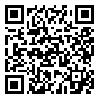BibTeX | RIS | EndNote | Medlars | ProCite | Reference Manager | RefWorks
Send citation to:
URL: http://jdisabilstud.org/article-1-3263-en.html
2- Assistant Professor, Department of Psychology, Rasht Branch, Islamic Azad University, Rasht, Iran
3- Assistant Professor, Department of Nursing and Midwifery, Rasht Branch, Islamic Azad University, Rasht, Iran
Abstract
Background & Objectives: University admission is a very sensitive stage with new communication experiences with the opposite sex. Love trauma syndrome is a set of severe signs and symptoms that appear after the breakup of a romantic relationship and disrupt a person's performance in many social, academic, and professional fields. Studies have shown that strong family relationships protect young people from experiencing a wide range of adversities and mental health problems; the family relationship is an essential variable in increasing or decreasing feelings of loneliness in young people. It also seems that the relationship between family communication patterns and loneliness sometimes occurs due to the mediating effect of another variable, such as psychological distress. The present study used structural equation modeling for the relationship between conversational and conformity family communication patterns and loneliness with the mediating role of psychological distress among university students with emotional breakdown experiences.
Methods: The method of this research was descriptive correlational based on structural equation modeling. The research population included all the female students of Islamic Azad University, Rasht Branch, Rasht City, Iran, in the 2021–2022 academic year. A total of 314 qualified volunteers of this population were included in the study by the purposive sampling method according to the inclusion and exclusion criteria. The inclusion criteria included participants' satisfaction, experience of emotional failure (a score greater than 20 from the Rosse love trauma syndrome questionnaire), age range between 18 and 35 years, and at least three months passed since the end of the relationship. The exclusion criteria included failure to complete the questionnaire and acute physical and mental disorders such as psychosis, bipolar disorder, or borderline personality disorder (self–report). The instruments used in this research were the Love Trauma Syndrome Questionnaire (Rosse, 2001), Loneliness Questionnaire (Asher et al., 1984), Family Communication Patterns Questionnaire (Koerner & Fitzpatrick, 2002), and Psychological Distress Scale (Kessler et al., 2002). The Pearson correlation coefficient and structural equation method were performed in SPSS version 26 and AMOS version 24 at a significance level of 0.05 to analyze the data.
Results: In the fitted model, the direct effects of the conversational family communication pattern on emotional loneliness (b=–0.22, p<0.001) and on social loneliness (b=–0.16, p<0.001) were negative and significant. Also, the direct effects of the conformity family communication pattern on emotional loneliness (b=0.53, p<0.001) and social loneliness (b=0.48, p<0.001) were positive and significant. The direct effects of psychological distress on emotional loneliness (b=0.41, p<0.001) and social loneliness (b=0.39, p<0.001) were positive and significant. In addition, the direct effect of the conversational family communication pattern on psychological distress (b=–0.18, p<0.001) was negative and significant, and the direct impact of the conformity family communication pattern on psychological distress (b=0.89, p<0.001) was positive and significant. Also, the indirect effects of psychological distress in the relationship between conversational family communication patterns and two variables of emotional loneliness (b=–0.07, p<0.001) and social loneliness (b=–0.07, p<0.001) were negative and significant. Also, the indirect effects of psychological distress in the relationship between the conformity family communication pattern and two variables of emotional loneliness (b=0.29, p<0.001) and social loneliness (b=0.15, p<0.001) were positive and significant. According to the goodness of fit indices, the collected data showed that the model has a good fit (RMSEA=0.07, χ2/df=2.89, CFI=0.98, GFI=0.98, NFI=0.98, IFI=0.98, AGFI=0.93, TLI=0.97).
Conclusions: According to the results, the mediating role of psychological distress in the relationship between conversational and conformity family communication patterns with loneliness in students with emotional breakdown experiences is confirmed. Therefore, the results of this study may be promising to improve the conditions of students who experience emotional breakdown so that effective steps can be taken to reduce and prevent the anomalies and injuries of the future generation of society.
| Rights and permissions | |
 |
This work is licensed under a Creative Commons Attribution-NonCommercial 4.0 International License. |



